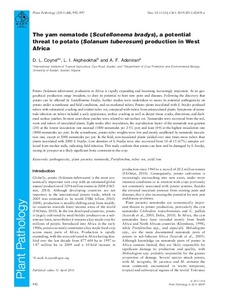| dc.contributor.author | Coyne, D.L. |
| dc.contributor.author | Akpheokhai, L.I. |
| dc.contributor.author | Adeniran, A.F. |
| dc.date.accessioned | 2019-12-04T11:09:18Z |
| dc.date.available | 2019-12-04T11:09:18Z |
| dc.date.issued | 2011-10 |
| dc.identifier.citation | Coyne, D.L., Akpheokhai, L.I. & Adeniran, A.F. (2011). The yam nematode (Scutellonema bradys), a potential threat to potato (Solanum tuberosum) production in West Africa. Plant Pathology, 60(5), 992-997. |
| dc.identifier.issn | 0032-0862 |
| dc.identifier.uri | https://hdl.handle.net/20.500.12478/2017 |
| dc.description | Published online: 11 April 2011 |
| dc.description.abstract | Potato (Solanum tuberosum) production in Africa is rapidly expanding and becoming increasingly important. As its geographical production range broadens, so does its potential to host new pests and diseases. Following the discovery that potato can be affected by Scutellonema bradys, further studies were undertaken to assess its potential pathogenicity on potato under screenhouse and field conditions, and on marketed tubers. Potato plants inoculated with S. bradys produced tubers with substantial cracking and evident tuber rot, compared with tubers from uninoculated plants. Symptoms of nematode infection on tubers included a scaly appearance, surface cracking as well as deeper tissue cracks, distortions, and darkened surface patches. In most cases these patches were related to sub-surface rot. Nematodes were recovered from the soil, roots and tubers of inoculated plants. Eight weeks after inoculation, the reproduction factor of the nematode was greatest (2·0) at the lowest inoculation rate assessed (1000 nematodes per 2·5-L pot) and least (0·4) at the highest inoculation rate (5000 nematodes per pot). In the screenhouse, potato tuber weights were low and mostly unaffected by nematode inoculation rate, except at 5000 nematodes per pot. In the field, non-inoculated plants yielded over nine times more tubers than plants inoculated with 2000 S. bradys. Low densities of S. bradys were also recovered from 10 of 15 (67%) samples collected from market stalls, indicating field infection. This study confirms that potato can host and be damaged by S. bradys, raising its prospect as a likely significant biotic constraint to the crop. |
| dc.format.extent | 992-997 |
| dc.language.iso | en |
| dc.subject | Pathogenicity |
| dc.subject | Plant Parasitic Namatodes |
| dc.subject | Pratylenchus |
| dc.subject | Yams |
| dc.subject | Yield Loss |
| dc.subject | Tuber Rot |
| dc.subject | Potato Production |
| dc.title | The yam nematode (Scutellonema bradys), a potential threat to potato (Solanum tuberosum) production in West Africa |
| dc.type | Journal Article |
| dc.description.version | Peer Review |
| cg.contributor.affiliation | International Institute of Tropical Agriculture |
| cg.contributor.affiliation | University of Ibadan |
| cg.coverage.region | Africa |
| cg.coverage.region | West Africa |
| cg.coverage.country | Nigeria |
| cg.isijournal | ISI Journal |
| cg.authorship.types | CGIAR and developing country institute |
| cg.iitasubject | Pests Of Plants |
| cg.iitasubject | Plant Diseases |
| cg.iitasubject | Yam |
| cg.journal | Plant Pathology |
| cg.howpublished | Formally Published |
| cg.accessibilitystatus | Limited Access |
| local.dspaceid | 85760 |
| cg.targetaudience | Scientists |
| cg.identifier.doi | http://dx.doi.org/10.1111/j.1365-3059.2011.02459.x |

